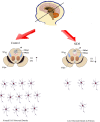The Mesencephalic Periaqueductal Gray, a Further Structure Involved in Breathing Failure Underlying Sudden Infant Death Syndrome
- PMID: 34623930
- PMCID: PMC8642109
- DOI: 10.1177/17590914211048260
The Mesencephalic Periaqueductal Gray, a Further Structure Involved in Breathing Failure Underlying Sudden Infant Death Syndrome
Abstract
The aim of this study was to investigate the involvement of the periaqueductal gray (PAG), an area of gray matter surrounding the cerebral aqueduct of Sylvius, in the pathogenetic mechanism of SIDS, a syndrome frequently ascribed to arousal failure from sleep. We reconsidered the same samples of brainstem, more precisely midbrain specimens, taken from a large series of sudden infant deaths, namely 46 cases aged from 1 to about 7 months, among which 26 SIDS and 20 controls, in which we already highlighted significant developmental alterations of the substantia nigra, another mesencephalic structure with a critical role in breath and awakening regulation. Specific histological and immunohistochemical methods were applied to examine the PAG cytoarchitecture and the expression of the tyrosine hydroxylase, a marker of catecholaminergic neurons. Hypoplasia of the PAG subnucleus medialis was observed in 65% of SIDS but never in controls; tyrosine hydroxylase expression was significantly higher in controls than in SIDS. A significant correlation was found between these findings and those related to the substantia nigra, demonstrating a link between these neuronal centers and the brainstem respiratory network and a common involvement in the sleep-arousal phase failure leading to SIDS.
Keywords: brainstem; dopamine; neuropathology; periaqueductal gray; sudden infant death syndrome; tyrosine hydroxylase.
Conflict of interest statement
Figures





Similar articles
-
Substantia Nigra Abnormalities Provide New Insight on the Neural Mechanisms Underlying the Sleep-Arousal Phase Dysfunctions in Sudden Infant Death Syndrome.ASN Neuro. 2020 Jan-Dec;12:1759091420962695. doi: 10.1177/1759091420962695. ASN Neuro. 2020. PMID: 32993318 Free PMC article.
-
Altered Development of Mesencephalic Dopaminergic Neurons in SIDS: New Insights into Understanding Sudden Infant Death Pathogenesis.Biomedicines. 2021 Oct 26;9(11):1534. doi: 10.3390/biomedicines9111534. Biomedicines. 2021. PMID: 34829763 Free PMC article.
-
New Step in Understanding the Pathogenetic Mechanism of Sudden Infant Death Syndrome: Involvement of the Pontine Reticular Gigantocellular Nucleus.Int J Mol Sci. 2024 Jun 25;25(13):6920. doi: 10.3390/ijms25136920. Int J Mol Sci. 2024. PMID: 39000030 Free PMC article.
-
The triple risk hypotheses in sudden infant death syndrome.Pediatrics. 2002 Nov;110(5):e64. doi: 10.1542/peds.110.5.e64. Pediatrics. 2002. PMID: 12415070 Review.
-
Midbrain control of breathing and blood pressure: The role of periaqueductal gray matter and mesencephalic collicular neuronal microcircuit oscillators.Eur J Neurosci. 2020 Oct;52(8):3879-3902. doi: 10.1111/ejn.14727. Epub 2020 May 1. Eur J Neurosci. 2020. Retraction in: Eur J Neurosci. 2021 Oct;54(7):6685. doi: 10.1111/ejn.15484. PMID: 32227408 Retracted. Review.
Cited by
-
A unified hypothesis of SUDEP: Seizure-induced respiratory depression induced by adenosine may lead to SUDEP but can be prevented by autoresuscitation and other restorative respiratory response mechanisms mediated by the action of serotonin on the periaqueductal gray.Epilepsia. 2023 Apr;64(4):779-796. doi: 10.1111/epi.17521. Epub 2023 Feb 15. Epilepsia. 2023. PMID: 36715572 Free PMC article. Review.
References
-
- Bandler R., Shipley M. T. (1994). Columnar organization in the midbrain periaqueductal gray: Modules for emotional expression? Trends in Neurosciences, 7(9), 379–389. https://doi.org/10.1016/0166-2236(94)90047-7 - DOI - PubMed
MeSH terms
Substances
LinkOut - more resources
Full Text Sources
Medical
